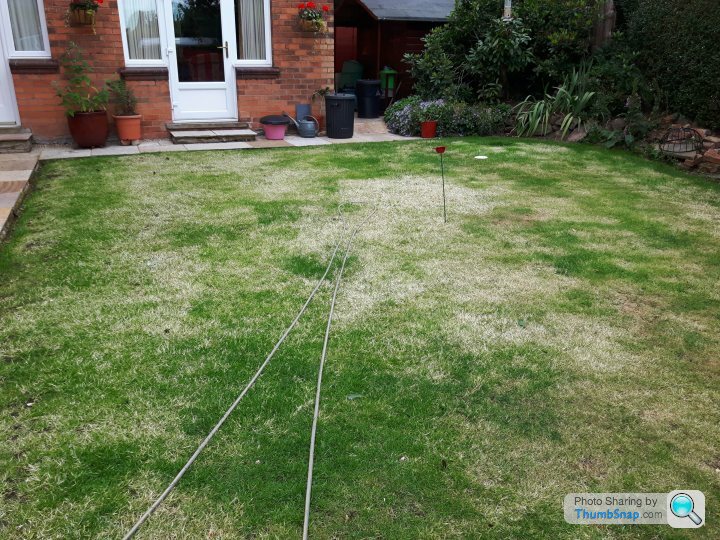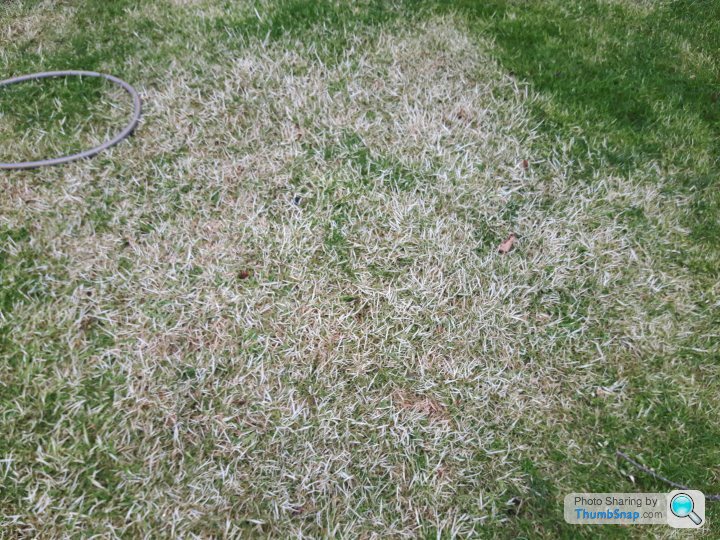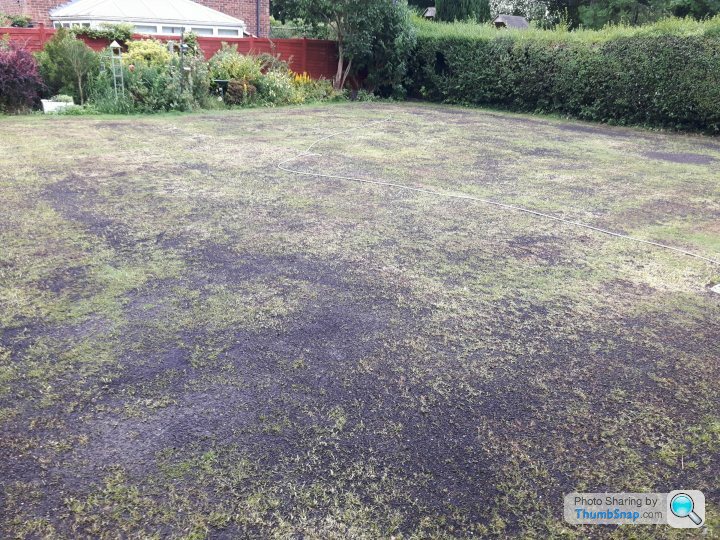2020 Lawn thread
Discussion
Jagnet - what an excellent article! Would it be possible for you to do a similar one but this time address how to look after a lawn on sandy soil? If you also have any suggestions to manage the problem of ants nests at the same time I, and I'm sure many others on here, would be eternally grateful.
jagnet said:
Don't worry, my frustrations aren't with you but rather with those recommending products because they're the latest fashionable thing but seemingly not really understanding what they do or the problem they're meant to answer, or why that problem is there in the first place. It's a bit like car detailing - things can get silly very quickly and miracle products come in and out of fashion all the time whilst the basic principal of shine coming from a perfectly smooth surface doesn't change.
It's also worth remembering that whilst they really are very good, Pitchcare (not a sponsor) is designed primarily to supply the professional groundsman and many of the products are intended for those customers. The demands of sports turf and the demands of a domestic lawn are very different. You would never willingly choose to build your lawn like a USGA putting green. If you wanted to deliberately create a really inhospitable environment for grass you couldn't do a much better job than build and maintain one of those.
The advantage of clay soil is that it's naturally excellent at retaining nutrients. Sandy soils are the ones that a more of a problem in that regard since nutrients are so easily washed through. Of course the problem with clay is drainage in wet weather and compaction, but in all cases the primary answer is always organic matter and soil structure.
How you introduce organic matter is down to you. The quickest route is through starting over and rotovating in fresh compost and topsoil. An example of this is excellent lawn makeover in the 2019 Lawn Thread. But a complete overhaul isn't for everyone so a slower method is through topdressing occasionally and/or mulching the clippings in situ, then let nature do the hard work of mixing it in over time. Organic matter will also build over time from the natural death and decomposition of root matter; unless the soil biology is lacking and then you get thatch buildup, waxy deposits and hydrophobic soils. If your soil biology is good then organic matter gives humus, and humus gives humic acid but to get to humic acid you need amino acids and the primary source of these is mycorrhizae.
This is where golf greens are an issue because generally organic matter is kept to a minimum in order to maintain consistent run of the ball and all too often fungicides are used and fungicides kill beneficial fungi just as quickly as harmful ones. Golfers won't generally appreciate the finer points of soil biology if it makes for a bogey on the third. Likewise worms, nature's aerators; brilliant in a lawn, frowned upon by those lining up a tricky putt on the fifth. So many worms have died over the years for the sake of ball sports, we shall remember them. In the old days the worms may have had the last laugh though as products designed to deal with them and available to public and professional user alike often included arsenic compounds. Karma. But that's nothing compared to the efforts humans have gone to in shooting large herbivores to prevent desertification around the world when it turns out that usually just makes things worse. We really are just dumb apes with an over heightened sense of our own importance sometimes.
Some mornings I wake up and worry that I'm turning into an eco warrior. But then I shower and shave and realise that can't possibly be true.
Soil structure. Avoid walking on the lawn when it's wet - compaction, elimination of air pockets and bad things will follow. No one likes an anaerobic soil, including grass, fungi and beneficial bacteria. Stinking black layers of nastiness form and the route to a zen like state of turf happiness will forever elude you. Aerate as often as you can to keep the surface open and the soil biology happy.
If you want to really improve soil structure and fertilise the lawn at the same time, then imho you just can't beat clover:
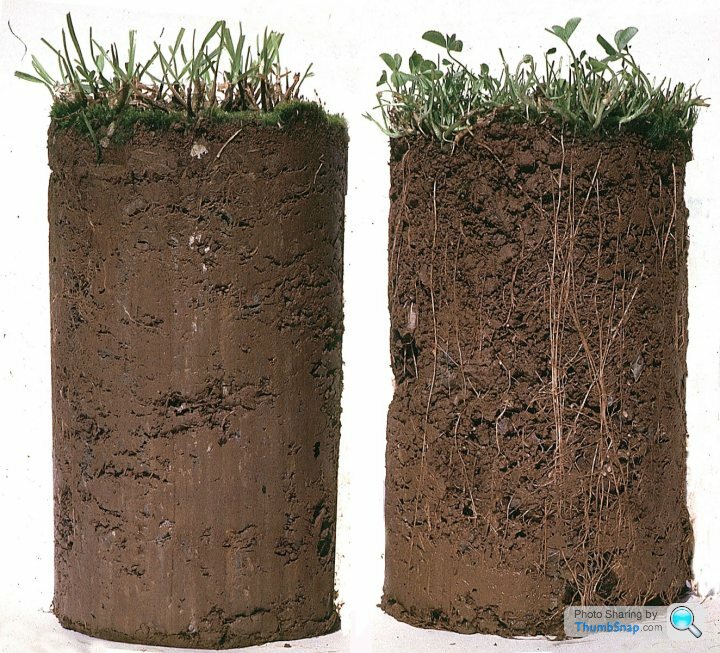
No clover on the left versus high clover content on the right, courtesy of Germinal (not a sponsor). Look at all those lovely lovely air pockets and channels to encourage deep root growth; gives me a warm feeling inside. But yeah, clover...urgh...bad...weed...must kill.
When it comes to fertiliser then I do like a good organic fertiliser and of these the
Maxwell Myco 1 and 2 have always been good to me (available from Pitchcare; not a sponsor) although other such fertilisers are available and at the basic level then blood, fish and bone, hoof and horn etc do the same job. It encourages the natural soil biology that works symbiotically with the grass since many of the nutrients are not immediately available to the grass and outside assistance from bacteria etc is required, which in the case of Myco 1 and 2 are handily prepackaged with the fertiliser so if your soil is lacking it's not a problem. If the nutrient breakdown is happening deeper in the soil close to the perennial grass roots and away from shallow rooted annual weed grasses, what are your shallow rooted annual weed grasses like Poa annua going to do? Now what if you spray liquid fertiliser on the same grasses so that it's immediately available to the plant for growth and seed production? Oooooh, suddenly it all starts to make sense.
In the beginning was stony ground and the stony ground begat weeds and the weeds begat annual grasses and the annual grasses begat perennial grasses. If you find that the lawn is working backwards, then something's awry. Imho you just need to listen to what the lawn is telling you, its natural inclination is towards the desirable perennial grasses but we keep hampering its efforts often through well intentioned but ultimately misguided actions. A bit like shooting elephants to prevent deserts forming.
Enough ramblings, I've got some clouds to shout at.
Really interesting read, and makes a lot of sense, brings a bit of balance and focus to the table. Great to see you posting on the thread.It's also worth remembering that whilst they really are very good, Pitchcare (not a sponsor) is designed primarily to supply the professional groundsman and many of the products are intended for those customers. The demands of sports turf and the demands of a domestic lawn are very different. You would never willingly choose to build your lawn like a USGA putting green. If you wanted to deliberately create a really inhospitable environment for grass you couldn't do a much better job than build and maintain one of those.
The advantage of clay soil is that it's naturally excellent at retaining nutrients. Sandy soils are the ones that a more of a problem in that regard since nutrients are so easily washed through. Of course the problem with clay is drainage in wet weather and compaction, but in all cases the primary answer is always organic matter and soil structure.
How you introduce organic matter is down to you. The quickest route is through starting over and rotovating in fresh compost and topsoil. An example of this is excellent lawn makeover in the 2019 Lawn Thread. But a complete overhaul isn't for everyone so a slower method is through topdressing occasionally and/or mulching the clippings in situ, then let nature do the hard work of mixing it in over time. Organic matter will also build over time from the natural death and decomposition of root matter; unless the soil biology is lacking and then you get thatch buildup, waxy deposits and hydrophobic soils. If your soil biology is good then organic matter gives humus, and humus gives humic acid but to get to humic acid you need amino acids and the primary source of these is mycorrhizae.
This is where golf greens are an issue because generally organic matter is kept to a minimum in order to maintain consistent run of the ball and all too often fungicides are used and fungicides kill beneficial fungi just as quickly as harmful ones. Golfers won't generally appreciate the finer points of soil biology if it makes for a bogey on the third. Likewise worms, nature's aerators; brilliant in a lawn, frowned upon by those lining up a tricky putt on the fifth. So many worms have died over the years for the sake of ball sports, we shall remember them. In the old days the worms may have had the last laugh though as products designed to deal with them and available to public and professional user alike often included arsenic compounds. Karma. But that's nothing compared to the efforts humans have gone to in shooting large herbivores to prevent desertification around the world when it turns out that usually just makes things worse. We really are just dumb apes with an over heightened sense of our own importance sometimes.
Some mornings I wake up and worry that I'm turning into an eco warrior. But then I shower and shave and realise that can't possibly be true.
Soil structure. Avoid walking on the lawn when it's wet - compaction, elimination of air pockets and bad things will follow. No one likes an anaerobic soil, including grass, fungi and beneficial bacteria. Stinking black layers of nastiness form and the route to a zen like state of turf happiness will forever elude you. Aerate as often as you can to keep the surface open and the soil biology happy.
If you want to really improve soil structure and fertilise the lawn at the same time, then imho you just can't beat clover:

No clover on the left versus high clover content on the right, courtesy of Germinal (not a sponsor). Look at all those lovely lovely air pockets and channels to encourage deep root growth; gives me a warm feeling inside. But yeah, clover...urgh...bad...weed...must kill.
When it comes to fertiliser then I do like a good organic fertiliser and of these the
Maxwell Myco 1 and 2 have always been good to me (available from Pitchcare; not a sponsor) although other such fertilisers are available and at the basic level then blood, fish and bone, hoof and horn etc do the same job. It encourages the natural soil biology that works symbiotically with the grass since many of the nutrients are not immediately available to the grass and outside assistance from bacteria etc is required, which in the case of Myco 1 and 2 are handily prepackaged with the fertiliser so if your soil is lacking it's not a problem. If the nutrient breakdown is happening deeper in the soil close to the perennial grass roots and away from shallow rooted annual weed grasses, what are your shallow rooted annual weed grasses like Poa annua going to do? Now what if you spray liquid fertiliser on the same grasses so that it's immediately available to the plant for growth and seed production? Oooooh, suddenly it all starts to make sense.
In the beginning was stony ground and the stony ground begat weeds and the weeds begat annual grasses and the annual grasses begat perennial grasses. If you find that the lawn is working backwards, then something's awry. Imho you just need to listen to what the lawn is telling you, its natural inclination is towards the desirable perennial grasses but we keep hampering its efforts often through well intentioned but ultimately misguided actions. A bit like shooting elephants to prevent deserts forming.
Enough ramblings, I've got some clouds to shout at.
You certainly make (and have made in the past) a good sales pitch for the Maxwell Myco products and the slow release and deeper fertilisation appeals to me. It makes sense that the liquid 'fast green up' products do the opposite, but where would Lawnsmith 'natur' which I have been using fit with that?
Valid points about professional turf care being very different to what is required for a domestic lawn, our daily walk takes us around and through a golf course and while the greens are a miracle in plant manipulation, there is not a single bit of the whole course which you would want on your lawn.
Here in the Wirral ridge we're on a sandstone base, in our case bedrock with 4-6inches of the surface, with shallow but good loam, if plenty of lumps of sandstone mixed in! We're going down the improve rather than rebuild route, including top dressing with a load of nice loamy soil taken from another area of the garden, but I might go back and read fastbikes76's makeover just for interest!
Cheers
Daniel
The lawn at the back is looking rather good at the moment but there is a section in quite heavy shade thatbInwant to start overseeding with a suitable grass seed.
This is the only one on Lawnsmith’s site, is it up to the job?
https://www.lawnsmith.co.uk/prod/lawn-grass-seed/s...
This is the only one on Lawnsmith’s site, is it up to the job?
https://www.lawnsmith.co.uk/prod/lawn-grass-seed/s...
langtounlad said:
Jagnet - what an excellent article! Would it be possible for you to do a similar one but this time address how to look after a lawn on sandy soil? If you also have any suggestions to manage the problem of ants nests at the same time I, and I'm sure many others on here, would be eternally grateful.
No worries. The answer for sandy soil is much the same: organic matter and soil structure. The difference is that rather than aiding drainage the organic matter and improved soil structure is helping to retain moisture as does the subsequent increase in earthworm coprolites through earthworm activity involved in the breaking down of the organic matter. This can be as much as a 20% increase in water retention through the earthworm coprolites alone versus control soil with minimal earthworm activity. Earthworms - marvellous little things. So the same methods to increase organic matter in clay soil apply to sandy soil.Again, like clay soil, clover can assist in improved soil structure although on very sandy soil it can be a little harder to establish a good clover mix versus clay or loamy soils, especially if faced with a particularly harsh summer. But reseeding in the autumn will replace that lost in the summer and over time the soil improvements will create greater resilience.
Compaction is less of an issue with sandy soils, although still an ever present issue and silty soil can compact quite badly. Regular aeration especially on highly trafficked areas makes a marked improvement and several studies have shown that frequent aeration with needle tines gives improved results over annual hollow tine aeration. One of those spiked rollers from Lawnsmith (not a sponsor) does the job perfectly well for the average sized lawn. Theirs is a fairly well built item; a lot don't look as though they'd make it through a single season.
Ants can make a mess, but it's usually just temporary until the flying ants emerge. You can get suitable nematodes which don't kill the ants but annoy them enough to move on. My preference though is to leave them to do their thing. Brush off any mounds before mowing and ponder on the myriad of channels being created in the soil as well as the possible improved soil fertility:
study said:
Our results confirm the major role of ant nests in influencing soil fertility and vegetation patterns and provide information about the factors that mediate these effects. First, ant nests improve soil fertility mainly through the accumulation of refuse materials. Thus, different refuse dump locations (external or in underground nest chambers) could benefit different vegetation life‐forms. Second, ant nests could increase plant diversity at larger spatial scales only if the identity of favoured plants changes along environmental gradients (i.e. enhancing β‐diversity). Third, ant species that feed on plants play a relevant role fertilizing soils, which may balance their known influence as primary consumers. Fourth, the effects of ant nests as fertility islands are larger in arid lands, possibly because fertility is intrinsically lower in these habitats. Overall, this study provide novel and quantitative evidence confirming that ant nests are key soil modifiers, emphasizing their role as ecological engineers.
The effects of ant nests on soil fertility and plant performance: a meta‐analysis. Alejandro G. Farji‐Brener & Victoria Werenkraut. 31 March 2017 https://doi.org/10.1111/1365-2656.12672I am very reluctant to try killing the ants. They weren't to know that the lawn was out of bounds and it's not like anyone put up a sign, written in ant, saying no ants allowed. Just seems a bit harsh when they're just minding their own business doing their ant thing.
Again, golfers tend to have a different opinion on ant mounds, but I'm fast coming to the conclusion that golfers are just naturally inclined towards mass killing. The Chairman Mao of sportspeople if you will. I'm joking, I'm sure golfers are lovely people and their fashion sense brings joy to millions.
Back on track, since sandy soil is less able to retain nutrients then slightly upping the amount of fertiliser applied through the year can be advantageous. So if say a ryegrass lawn on nice loamy soil subject to the usual rigours of family life required around 1.5kg of Nitrogen per 100m2 per year over multiple applications, then on heavy clay I might aim for 1kg and on sand perhaps 2kg as an initial target, but as always watch and adjust as required. An older lawn usually requires less than a new lawn, likewise fine turf less than ryegrass based family turf, shaded turf less than that in full sun, etc. If you mulch the clippings in situ then consider that they could provide up to 30% of the lawn's nitrogen requirement per year so adjust fertiliser quantities downwards as needed.
A fertiliser for sandy soil will usually have more P and K than that designed for clay soil. An autumn fertiliser will also have higher P and K relative to N so you could also apply that during the summer at a slightly higher rate. As an example, looking at Lawnsmith's fertilisers, their spring/summer fertiliser for clay has an NPK of 22-0-6, and their sandy soil version is 25-4-10.
dhutch said:
Really interesting read, and makes a lot of sense, brings a bit of balance and focus to the table. Great to see you posting on the thread.
You certainly make (and have made in the past) a good sales pitch for the Maxwell Myco products and the slow release and deeper fertilisation appeals to me. It makes sense that the liquid 'fast green up' products do the opposite, but where would Lawnsmith 'natur' which I have been using fit with that?
Valid points about professional turf care being very different to what is required for a domestic lawn, our daily walk takes us around and through a golf course and while the greens are a miracle in plant manipulation, there is not a single bit of the whole course which you would want on your lawn.
Here in the Wirral ridge we're on a sandstone base, in our case bedrock with 4-6inches of the surface, with shallow but good loam, if plenty of lumps of sandstone mixed in! We're going down the improve rather than rebuild route, including top dressing with a load of nice loamy soil taken from another area of the garden, but I might go back and read fastbikes76's makeover just for interest!
Cheers
Daniel
I promised myself I wouldn't post on it this year as it was taking up ever increasing amounts of time, but I found myself lured in once again You certainly make (and have made in the past) a good sales pitch for the Maxwell Myco products and the slow release and deeper fertilisation appeals to me. It makes sense that the liquid 'fast green up' products do the opposite, but where would Lawnsmith 'natur' which I have been using fit with that?
Valid points about professional turf care being very different to what is required for a domestic lawn, our daily walk takes us around and through a golf course and while the greens are a miracle in plant manipulation, there is not a single bit of the whole course which you would want on your lawn.
Here in the Wirral ridge we're on a sandstone base, in our case bedrock with 4-6inches of the surface, with shallow but good loam, if plenty of lumps of sandstone mixed in! We're going down the improve rather than rebuild route, including top dressing with a load of nice loamy soil taken from another area of the garden, but I might go back and read fastbikes76's makeover just for interest!
Cheers
Daniel

From their description, The Lawnsmith Natur is part organic so you'll get the more immediate affect from the non organic part whilst still benefiting from the organic side gradually improving things in the soil. I'd put it down as a nice halfway house option. People like to see some quick results after fertilising, which is fine, and if it makes people more inclined to make the transition to organic fertilisers then that can only be a good thing imho.
Re golf courses, I wouldn't want anyone to think I'm knocking the greenkeepers. They do a remarkable job, usually with inadequate resources whilst trying to match unrealistic expectations from committee members. It's just that by their very nature golf greens are almost designed to favour annual weed grasses over the finer perennials and so bad has it become for some courses that their greens are now almost 100% Poa annua and the greenkeepers have had to adapt to managing that rather than the fescues and bents of old. Some greenkeepers have seen success in the use of compost teas for example together with a regular overseeding program to transition the greens back towards the perennials, but it's a constant fight against the inadequacies of the rootzone to support those perennials together with the constant prodding and poking of the sward to achieve the visual appeal and fast run of the ball so demanded by the players. I'm never sure which is more stressed, the grass or the greens staff.
The gradual improvement of soil is entirely possible, it just requires patience. But then nature usually does and we tend to forget that with the immediacy of modern life. In the very old days the establishment of a quality lawn was a long drawn out process that could take a couple of years to allow the soil to settle and the existing seedbank to become exhausted, before finally establishing the new lawn through plugs of grass taken from elsewhere. It was definitely not for those that lacked patience.
DonkeyApple said:
The lawn at the back is looking rather good at the moment but there is a section in quite heavy shade thatbInwant to start overseeding with a suitable grass seed.
This is the only one on Lawnsmith’s site, is it up to the job?
https://www.lawnsmith.co.uk/prod/lawn-grass-seed/s...
Their ‘shady green’ did this for me in four weeks. It’s under a pine tree and it’s always been a nightmare for the grass below. This is the only one on Lawnsmith’s site, is it up to the job?
https://www.lawnsmith.co.uk/prod/lawn-grass-seed/s...
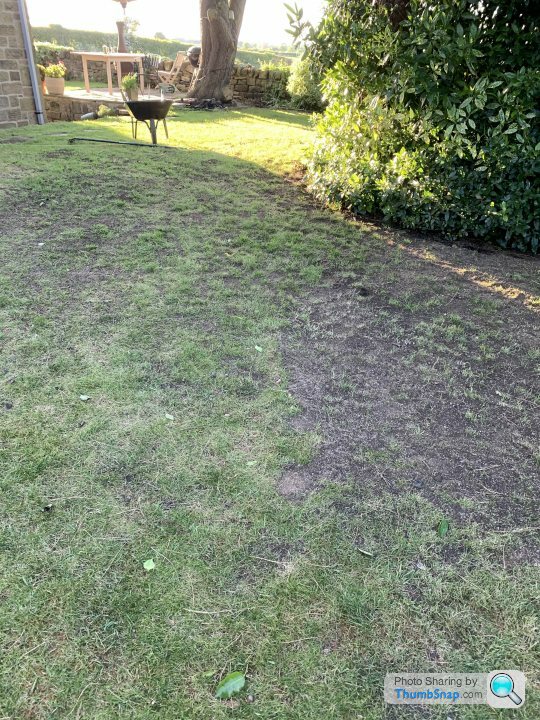
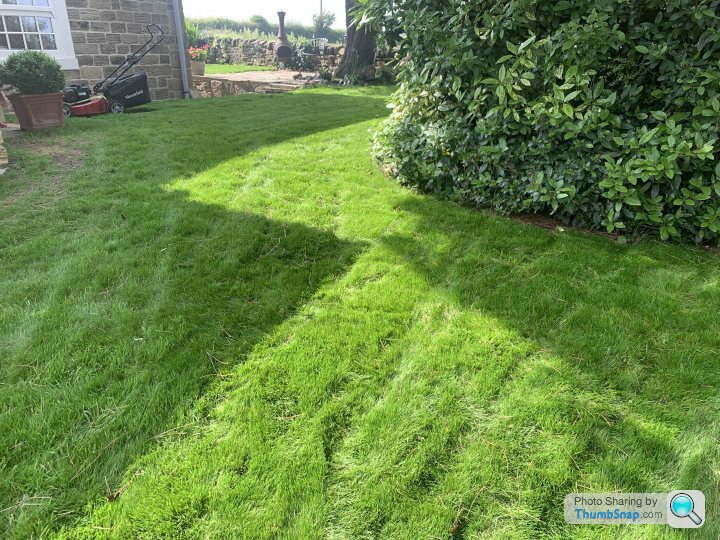
Crumpet said:
DonkeyApple said:
The lawn at the back is looking rather good at the moment but there is a section in quite heavy shade thatbInwant to start overseeding with a suitable grass seed.
This is the only one on Lawnsmith’s site, is it up to the job?
https://www.lawnsmith.co.uk/prod/lawn-grass-seed/s...
Their ‘shady green’ did this for me in four weeks. It’s under a pine tree and it’s always been a nightmare for the grass below. This is the only one on Lawnsmith’s site, is it up to the job?
https://www.lawnsmith.co.uk/prod/lawn-grass-seed/s...


I take it the one you used isn’t the same one in the link?
Also, how is the grass a few months on? I’ve always found that any old seed will look great when new but within a few months it can thin out and go whispy then kaput.
RichB said:
jagnet said:
Ok that's better. Well I can't see any signs of red thread there. I think it was just wisps of dead leaf matter I could see in the other pictures. It's pretty thin turf even accounting for the fact that it's now a bit dead. You say the soil is moist still; is that just at the surface? How's the moisture levels further down? I'm reluctant to say dry patch. It just doesn't sit right with me to have the grass wilt so quickly and dry patch is becoming a bit of a standard go to issue, often when it's not the problem.
Clearly something has been causing the grass to thin and struggle for a while. Even if it looked ok from a distance before it's clearly not happy and presumably coinciding with hot weather it's all become a bit too much. My gut feeling is there's issues with root health there for what could be a number of reasons.
I think you need to look deeper. I would get a spade and neatly dig out a section of soil across an affected patch. How compacted is it? What's the soil like? Is there debris under the surface? Is there a defined changed in soil type that roots don't want to cross. How deep are the roots growing? Are there any pests eating away at the roots? Is it too wet causing roots to rot?
thanks, I'll have a dig at the weekend. Certainly not seen any leather jackets and only a few ants. The turf is 2 1/2 years old now and the subsonic was well prepared with several inches of fresh topsoil put on top. It's all in one area which made me think fungal it's too late to complain about the turf now! P.s. Bagshot sand so good drainage and acidic Clearly something has been causing the grass to thin and struggle for a while. Even if it looked ok from a distance before it's clearly not happy and presumably coinciding with hot weather it's all become a bit too much. My gut feeling is there's issues with root health there for what could be a number of reasons.
I think you need to look deeper. I would get a spade and neatly dig out a section of soil across an affected patch. How compacted is it? What's the soil like? Is there debris under the surface? Is there a defined changed in soil type that roots don't want to cross. How deep are the roots growing? Are there any pests eating away at the roots? Is it too wet causing roots to rot?
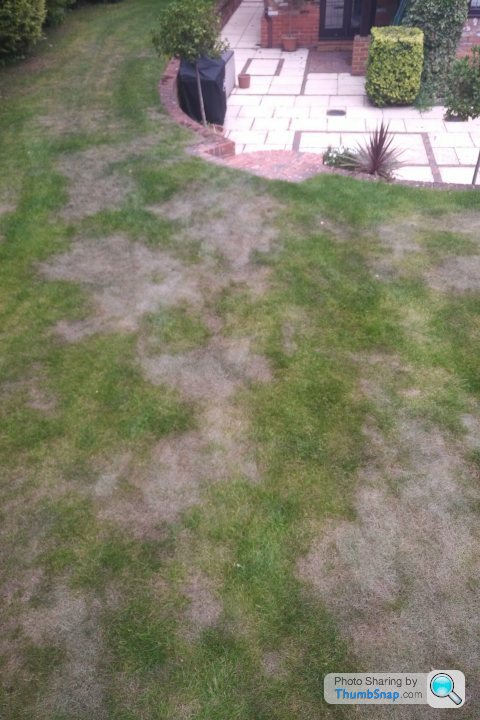
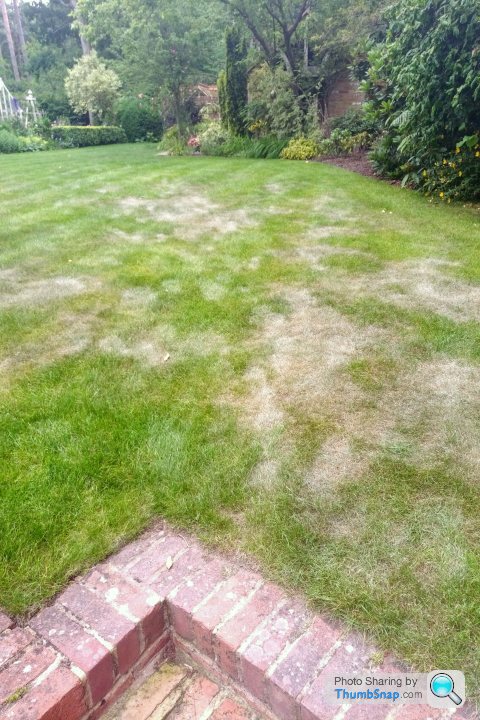
RichB said:
Not been out today because I've busy with other stuff but here's a picture from Friday, As you can see the grass wilted on Thursday and by Friday the top was dead. It's the patchiness of it that puzzles me. If it was lack of water it would be the whole area but between the dead areas there's strong growing green grass. Once it gets going again I will feed it to get it to green up, thoroughly aerate it and then in Sept feed it with a good phosphorous fertilser to encourage root growth. It's annoying and disappointing because 75% of the lawn area is very good but this area on one side closer to the house is horrible.


Well that definitely looks fungal in nature now but not red thread. It actually looks like summer patch, maybe, but I've not seen that on a UK lawn to that extent before. I think it would fit though - sheltered area so poor air circulation, warm temperatures, moisture. Not being in the UK I'm not fully up on recent weather but I'm told it's been very warm.

I would avoid that area for now so as not to walk it around the rest of lawn. If it is magnaporthe poae then you'll be needing to reseed in the autumn as the grass won't recover. Rotting roots would be a strong indication that that's what it is.
5harp3y said:
I like the idea of the clover mixes if it helps with the lawn too
DLF do a mix called Eco Lawn using their microclover, which is a specially bred small leaved variety of white clover that rarely flowers. If you've got an aversion to bees that's probably a good one to go for. They can also supply the microclover seed on its own, but I think it's a minimum of 1kg.Germinal have their own version called AberSustain. Whilst it is a small leaved white clover it is a little larger than DLF's and does flower more frequently. They may well supply that in packages smaller than 10kg if you call them.
Other clover seed mixes are available from smaller seed suppliers as well.
I've mixed DLF's microclover with Germinal's grass seed mixes such as SoGreen to good effect in the past, adding clover seed make up about 5% of the total by weight. Our pet rabbits thoroughly enjoyed munching on a clover rich lawn, so there we go - rabbit approved

DonkeyApple said:
Thanks. They only seem to have one ‘shade’ grass and it doesn’t exactly rush to shout about being ideal for shade.
I take it the one you used isn’t the same one in the link?
Also, how is the grass a few months on? I’ve always found that any old seed will look great when new but within a few months it can thin out and go whispy then kaput.
Ah, well, can’t answer that about longevity, I’m afraid. I suspect it will probably need a top dressing and reseed every spring but nothing too exciting. To be honest this is the first year I’ve taken an interest in keeping my lawn alive!I take it the one you used isn’t the same one in the link?
Also, how is the grass a few months on? I’ve always found that any old seed will look great when new but within a few months it can thin out and go whispy then kaput.
It was this one;
https://www.lawnsmith.co.uk/prod/lawn-grass-seed/s...
Ok guys, hopefully someone can give me a pointer here.
I may be worrying overly, buy having seeded my lawn its coming alomg nivcely, well most of it. Except the yellowy anemic looking bit in the foregoround.
the rest ive mowed twice and its largely dense and green. This bit hasnt really got long enough for the mower to touch it, its certainly not dense and i can still see the soil.
Any ideas?
I will say at this point, that in this area, there has been a pile of "as dug" limestone for over a year until about march this year.
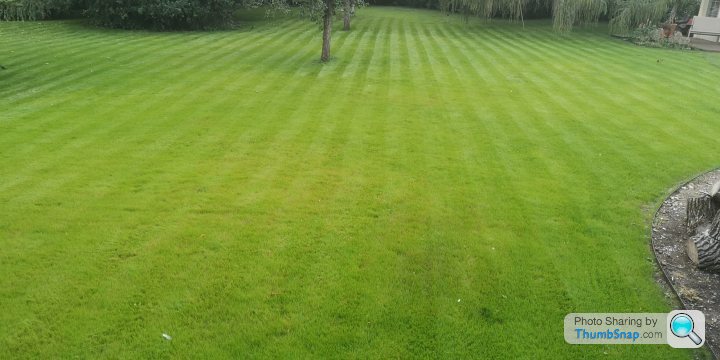
I may be worrying overly, buy having seeded my lawn its coming alomg nivcely, well most of it. Except the yellowy anemic looking bit in the foregoround.
the rest ive mowed twice and its largely dense and green. This bit hasnt really got long enough for the mower to touch it, its certainly not dense and i can still see the soil.
Any ideas?
I will say at this point, that in this area, there has been a pile of "as dug" limestone for over a year until about march this year.

It's the go-to product in the States. Well, the active ingredient is anyway (mesotrione). You used to be able to get it in this country but I'm not sure now, I think it has been removed from circulation. I'm not aware of it being available to consumers.
You can find it on ebay.com, but what the risks are re importing it I don't know.
You can find it on ebay.com, but what the risks are re importing it I don't know.
r44flyer said:
Ok, fair enough, and you are in the UK and bought this online?Appears to be reasonable safe to human (inc controlled use on crops) but very toxic to aquatic life with long lasting effects, to guess need to ensure zero run-off, not suitable for people with streams near by etc.
Syngenta Acuron is another name for the same thing. Where most of the uk chems appear to be MCPA based.
Humm, basically still much more up for trying to do it naturally and encourage the right grasses rather than kill off the wrong ones, but also there is sometimes and argument for a one of dose of something to correct the balance if something odd happens.
Might try the scarifier on a small but and see, I think it might do a good job and taking it out ahead of reseeding.
Daniel
Gassing Station | Homes, Gardens and DIY | Top of Page | What's New | My Stuff



